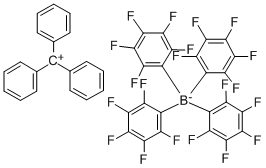 | ||
Lithium tetrakis(pentafluorophenyl)borate is the lithium salt of the weakly coordinating anion (B(C6F5)4)−. Because of its weakly coordinating abilities, lithium tetrakis(pentafluorophenyl)borate makes it commercially valuable in the salt form for the starting material in polymerization reactions and electrochemistry. It is a water-soluble compound. Its anion is closely related to the non-coordinating anion known as BARF.
Contents
Structure and properties
The anion is tetrahedral with B-C bond lengths of approximately 1.65 Angstroms. The salt has only been obtained as the etherate, and the crystallography confirms that four ether molecules are bound to the lithium cation, with Li-O bond lengths of approximately 1.95 Angstroms. This structure gives the Lithium ion a coordination number of 4 with a tetrahedral geometry.
Preparation
The salt was first produced in studies on tris(pentafluorophenyl)boron, a well known Lewis acidic compound. Combining equimolar ether solutions of pentafluorophenyllithium and tris(pentafluorophenyl)boron gives the lithium salt of tetrakis(pentafluorophenyl)borate, which precipitates as a white solid as the etherate:
(C6F5)3B + Li(C6F5) → [Li(OEt2)3][B(C6F5)4]Since its discovery, many revised syntheses have been described.
Reactions
Lithium tetrakis(pentafluorophenyl)borate is primarily used in its salt form as a precursor to cationic transition metal complexes. They are capable of forming highly reactive metal catalysts. Lithium tetrakis(pentafluorophenyl)borate is used for its bulky size in primarily polymerization reactions and electrochemistry. (B(C6F5)4)− is a weakly coordinating anion, which is compatible with strong electrophiles. This property is essential for the activation of Ziegler-Natta and Metallocene olefin polymerization catalysts. For example, polymerization by zirconocene catalysts can be initiated with the (B(C6F5)4)− salt of the trityl carbocation [Ph3C]+ : Borate salts of dimethyl annilinium and triethyl ammonium have also been reported to act as successful cocatalysts/activators.
In such cases, the required lithium salt of (B(C6F5)4)− is prepared from Li(B(C6F5)4) and [Ph3C][B(C6F5)4]. Another use is in the creation of (η5-pentamethylcyclopentadienyl)tin tetrakis(pentafluorophenyl)borate. This cation is then applied as an efficient Ziegler-Natta α-olefin cocatalyst for the polymerization of alkenes.
